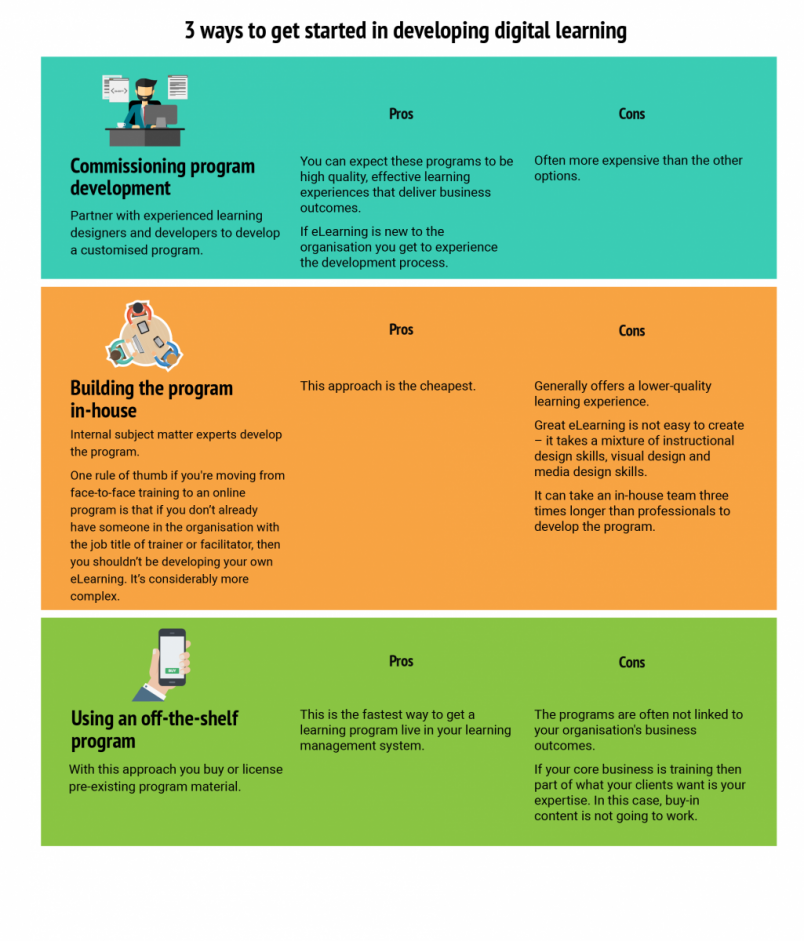When you’re just beginning with e-learning, getting your learning management system in place is just one of the stepping stones. For many learning and development people, the IT aspects of a learning management system implementation project can seem like the biggest hurdle.
But having the technology in place is only one part of the puzzle. What you do with the technology is more important. Tools such as Totara Lear are highly flexible, but they can seem like a daunting blank canvas at first.
There are three common ways to getting started in self-paced e-learning:

Getting started with using off-the-shelf content
We are seeing the accelerated uptake of e-learning in organisations using existing programs. The organisation licenses content libraries such as Lynda.com and then adopts a content curatorship-style approach.
In some sectors, including government, there are formal and informal networks for sharing resources, which can save everyone time and money.
Lynda.com and Totara LMS
The simplest way we have found to work with Lynda.com and Totara is using the Learning Technologies Intergration (LTI) standard. This is set up in Totara using the ‘external tool’ activity. Completion data from Lynda.com is sent back to the LMS.
In this case, Totara LMS becomes the central hub for employees’ learning, and they are not directed to multiple locations.
One organisation we have been working with has said to its employees that if there is course material in Lynda.com that is of personal interest, for example photography, then they are welcome to use it outside of work time.
By doing so, they are implying that self-directed learning is important and the LMS is not just about compliance training.
Getting better results from Lynda.com using content curatio
Content curation is the process of collecting and organising content in a meaningful way. A huge library of resources like Lynda.com can be overwhelming.
To get over this challenge, we can develop a selection of courses that can be curated and highlighted to employees, to help guide them to the content that is most relevant. The next stage is to begin to build sophisticated blended learning experiences around off-the-shelf content.
One of the issues with content libraries is that they don’t directly address the issues your organisation is having.
A simple and effective solution is to use the material from the course library as one component of the program and then add more learning activities. For example, a course in customer service might begin with a discussion on what good customer service looks like.
The next stage might be a Lynda.com course on customer service, after which the learner could do a self-assessment that is built as a quiz in Totara LMS. Finally, the course could finish with a reflective discussion topic where the learner might answer questions such as what they would do differently from now on.
This is simple to build – it’s really just a quiz and some discussions. To be successful, the discussions need to be actively facilitated. Having a group complete the program together would increase the likelihood that they would work well.
Having access to a library of learning resources like Lynda.com provides learners with choices and provides the bedrock for a learning ecosystem. Lynda.com integrates easily with Totara Learn and is a great way to get started in e-learning.
Interested in how Totara LMS can work with Lynda.com? Get in touch today!
This is a guest post from Sprout Labs’ Robin Petterd. For more from Sprout Labs, check out Robin’s recent interview with our Chief Commercial Officer, Lars Hyland.


